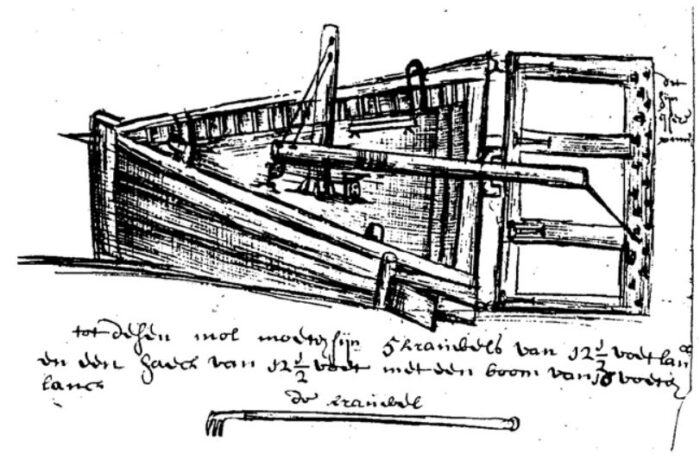
Spuidokken, Kolk en afvoerkanaal
Water reservoirs, Whirlpool and outlet to the river

Spuidokken rechts boven en onder
Water reservoirs at the right, above and below

De krabbelaar
The scribbler
WERKEN MET WATER
In de zestiende eeuw bloeide ons land economisch snel op. Daardoor nam het vervoer toe. Vooral het vervoer over water breidde zich uit. Ons land floreerde, mede door het vele aanwezige water. Een handicap daarbij was het verzanden van de havens. Havens en rivieren hebben te maken met de getijbeweging van de zee: eb en vloed. Door de geringe stroomsnelheid van het water worden klei en zand op de bodem afgezet.
De havens slibden dus langzaam maar zeker dicht. Ook Maassluis had voortdurend last van dit probleem. De positie van onze haven was strategisch. Voor het dorp was het van essentieel belang dat de schepen met hun visvangst en handelswaren konden blijven binnenlopen. Dat betekende dat de haven voortdurend moest worden uitgediept.
In Maassluis werd de haven op diepte gehouden met spuien en krabbelen. Er waren twee spuidokken (spaarbekkens), de Noordgeer en de Zuidgeer. Die kwamen uit in de havenkom, de Kolk. Dat is het water waar u bij staat. De Zuidgeer is gedempt. De Noordgeer is het water achter de brug die u ziet.
Wist u dat geer komt van vergaren (verzamelen)?
Door middel van deuren konden de spuidokken worden geopend en afgesloten. Met hoog water liepen de dokken vol en werden de deuren gesloten. Bij eb werden met halftij de deuren geopend. Het opgespaarde water stroomde van twee kanten de Kolk in. Dan kolkte het er, vandaar de naam. Uit de Kolk spoelde het water dan door de haven naar de rivier. Dan werd ook de krabbelaar ingezet. Dat was een schip met aan de achterzijde twee uitklapbare delen met scherpe uitsteeksels. Hiermee werd de havenbodem losgewoeld. De krabbelaar werd bediend door twee mensen op de kade. Het water dat terugstroomde naar de rivier hielp bij de voortgang van de krabbelaar. Deze kreeg ook extra vaart door de opvallend brede achterkant. Met de scherpe uitsteeksels als een soort ‘eg’ schraapte men de bodem los. De stroming voerde het slib mee en zo werd de vaargeul uitgediept en schoongemaakt.
In de haven waren ook twee sluizen die gebruikt werden om het water uit de polder te lozen. U ziet die sluizen aan beide zijden van de kade waar u op staat. Afhankelijk van de waterstand van deze vlieten in het dorp werd ook dit polderwater gespuid als het water in de haven gespuid werd. Omdat er bij het spuien veel waterverplaatsing en snelle stroming was, werden de schepen in de havenkom gewaarschuwd. Dat gebeurde door middel van de bel boven u aan de gevel.
++++++++++++++++++++
LET WATER DO THE WORK
In the sixteenth century, the economy in the Netherlands flourished quickly. As a result, transport increased. Water transport in particular expanded. Our country flourished, partly due to the abundance of water. A handicap was the silting up of the ports. Harbours and rivers are effected by the tidal movement of the sea: ebb and flow. Due to the low flow speed of the water, clay and sand are deposited on the bottom.
So the ports silt up slowly but surely. Maassluis was also constantly bothered by this problem. The position of our port was strategic. For the village it was essential that the ships could keep barging in with their catches and merchandise. This meant that the port had to be continuously deepened. In Maassluis, the harbour was kept at depth with draining and scraping. There were two draining docks, reservoirs for gathering water and sluicing it later on. Both ended in the harbour basin, the Kolk (Whirlpool). That’s the water you are standing by. Nowadays the dock at the South side is filled in. The draining dock at the North side is the water behind the bridge that you see.
The docks could be opened and closed by means of doors. At high tide the docks were filled and the doors were closed. After the ebb tide started the doors were opened at half-tide. The accumulated water flowed into the Kolk from two sides. Then it swirled, hence the name. The water then washed out of the Kolk through the harbour to the river. At that moment the scribbler was deployed. That was a ship with two folding parts with sharp protrusions at the rear. With this, the harbour floor was loosened up. The scribbler was served by two people on both sides of the harbour. The water that flowed back to the river helped the scribbler’s progress. It also gained extra momentum due to the extra wide rear. The soil was scraped loose with the sharp protrusions like a kind of “harrow”. The current carried the sludge with it and so the navigation channel was deepened and cleaned.
There were also two sluices in the harbour that were used to discharge the water from the polders. One of them was later converted into a lock. You will see the sluice and the lock on both sides of the quay you are standing on. Depending on the water level of these drains (canals) in the village, this polder water was also drained when the water was drained in the port. Because there was a lot of water displacement and fast currents during the discharge, the ships in the harbour basin were warned. This was done by means of the bell above you on the facade.

Spuidokken, Kolk en afvoerkanaal
Water reservoirs, Whirlpool and outlet to the river

Spuidokken rechts boven en onder
Water reservoirs at the right, above and below

De krabbelaar
The scribbler